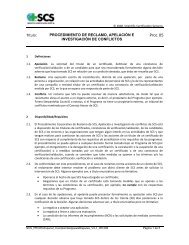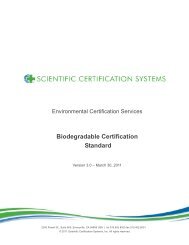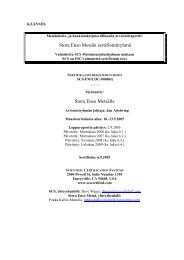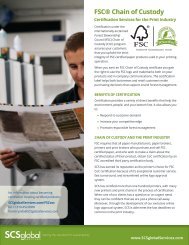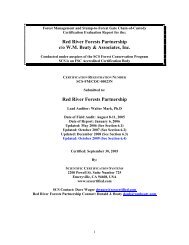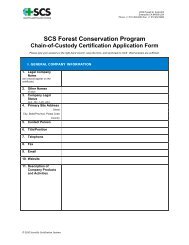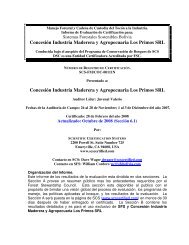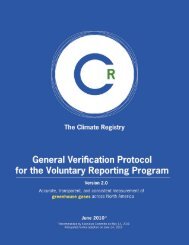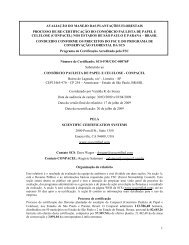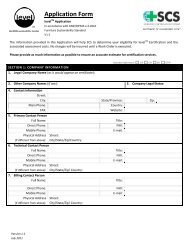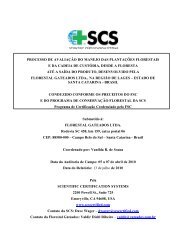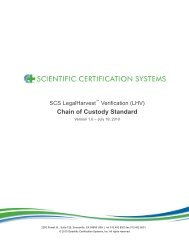here - SCS Global Services
here - SCS Global Services
here - SCS Global Services
You also want an ePaper? Increase the reach of your titles
YUMPU automatically turns print PDFs into web optimized ePapers that Google loves.
Certifi ed Environmental Product Declaration<br />
Dimensional Lumber Products Produced by Humboldt Redwood Company<br />
Highlights of Declaration:<br />
• Certified Restorative Forestry<br />
• Certified Net Carbon Storage Forest<br />
DRAFT, do not use, cite, copy or distribute<br />
© 2011 Scientific Certification Systems
Introduction<br />
This Environmental Product Declaration (EPD)<br />
summarizes the results of a life cycle assessment (LCA)<br />
of untreated dimensional lumber produced by the<br />
Humboldt Redwood Company (HRC). In this study,<br />
HRC forest management practices were compared to<br />
practices on the same lands under the prior owner, the<br />
Pacific Lumber Company (PALCO).<br />
The LCA was conducted by an independent third party<br />
certifier, Scientific Certification Systems (<strong>SCS</strong>certified).<br />
Based on the study results summarized <strong>here</strong>in, <strong>SCS</strong> has<br />
certified HRC as a Restorative Forestry Operation and its<br />
forest as a Net Carbon Storage Forest.<br />
HRC Certifi cation Highlights<br />
HRC’s practices have already:<br />
• Changed the forest from a net carbon source to a net carbon sink, mitigating the<br />
contribution to climate change, ocean acidification and ocean thermal changes<br />
• Reduced the use of toxic herbicides by almost 95%<br />
• Completely halted all cutting of old growth redwood and Douglas fir on the property<br />
Over time, HRC’s Restoration Forestry will recover:<br />
• 88,000 acres of previously disturbed forestland<br />
• Habitat for as many as 13 key species<br />
• Over 2,500 miles of disturbed rivers, across 7 major watersheds<br />
• Forest carbon storage removing over 6 million tons of CO2 from the atmosp<strong>here</strong><br />
—equivalent to removing almost 1 million cars from the road<br />
An LCIA Comparison of Forestry Under PALCO and HRC<br />
A selective harvest site at HRC.<br />
Photo taken June 2011.
1860s - Forestry begins<br />
1931-86 - PALCO/Murphy selective forestry<br />
1986 - Hostile takeover of PALCO by Maxxam<br />
1986-99 - Extreme impact forest management<br />
1999 - Habitat Conservation Plan (HCP) Enacted<br />
2001- SFI Certification through 2007<br />
2007 - PALCO Bankruptcy<br />
2008 - HRC Acquisition<br />
2009 - FSC Certification<br />
2011- Projected long-term forest recovery<br />
History of the Forest<br />
The HRC forest covers approximately 209,000 acres in<br />
Humboldt County, California, approximately 250 miles<br />
north of San Francisco. The forest is composed primarily<br />
of coastal redwood, Douglas fir, and hardwoods such as<br />
tanoak.<br />
Forestry began on the property in the 1860s under PALCO<br />
when owned by the Murphy Family, which conducted a<br />
form of selective forestry. A major transition occurred in<br />
1986, when Maxxam Corporation acquired PALCO in<br />
a hostile takeover. PALCO/Maxxam engaged in highly<br />
destructive practices, incorporating widespread clear<br />
cuts and the liquidation of old growth trees. This led to extensive direct forest disturbance,<br />
indirect disturbance to seven major watersheds, and the loss of habitat for as many as 16<br />
threatened, endangered or rare species .<br />
Forestry At HRC<br />
A Douglas fir stand marked for<br />
selection harvest.<br />
(From the HRC website.)<br />
HRC’s purchase of the forest marked a new era in forest management practices. Forestry<br />
under HRC incorporates uneven-aged management and selective forestry, all geared<br />
towards restoring the forest to a healthier state. All clear cuts which had been planned were<br />
halted, and HRC management made the commitment to the local community to never cut<br />
another old growth tree.<br />
DRAFT, do not use, cite, copy or distribute ©2011 Scientific Certification Systems
Scope of the LCA<br />
The LCA study focused on HRC untreated dimensional lumber produced during the<br />
current calendar year (2011). HRC’s lumber is used for residential applications, including<br />
redwood decking (65% of total production) and Douglas fir structural beams (35% of total<br />
production).<br />
The study involved an examination of all impacts associated with this lumber production<br />
from cradle to gate, including forestland management, wood extraction, milling and<br />
distribution to retail. The study did not address impacts from the use and disposal of this<br />
product.<br />
An LCIA Comparison of Forestry Under PALCO and HRC
PALCO Reference Baseline<br />
Forestry practices under PALCO/Maxxam<br />
served as the baseline for comparison for this<br />
study. Before going bankrupt, PALCO was<br />
in the process of transforming the forest into<br />
a 35-year rotation “tree farm.” This type of<br />
A PALCO clear cut near the Headwaters Forest forestry suppresses less-profitable Douglas firs<br />
reserve. Photo from KRIS Photo Database.<br />
and tanoak, keeps redwoods in a permanently<br />
immature state, and reduces the landscape to<br />
a patchwork of clear cuts. This landscape is highly disturbed, with immature compositional<br />
structure and no suitable habitat for keystone species.<br />
Based on these practices, PALCO’s operations<br />
resulted in extreme, forest impacts including the<br />
irreversible loss of more than 380,000 old growth<br />
trees, complete disturbance to 66,000 acres of<br />
second growth forest resulting from 88,000 acres<br />
of cuts, high levels of disturbance to seven major<br />
watersheds on the property, the loss and disturbance<br />
of optimal habitat for as many as 16 species, and<br />
the elimination of millions of tons of carbon storage<br />
in old growth redwood and Douglas fir trees.<br />
The Northern Spotted Owl<br />
DRAFT, do not use, cite, copy or distribute ©2011 Scientific Certification Systems
Impact Profi le of the PALCO Baseline<br />
The impacts shown in the table reflect the results of 21 years of PALCO forest management<br />
practices, based on average of 232 million Board-Feet (MMBF) each year. These values<br />
reflect the state of the forest in 2008, when HRC began operations.<br />
Forest management under PALCO led not only to a high rate of disturbance for many<br />
indicators, but also to accumulating disturbance and emissions due to lack of active<br />
mitigation efforts. Many of these indicators are irreversible in nature, and cannot be<br />
reversed.<br />
The restoration forestry practiced by HRC is working to mitigate these impacts to the<br />
degree that is possible.<br />
An LCIA Comparison of Forestry Under PALCO and HRC
���������������������� ������������� ������<br />
�����������������������������<br />
�������������������������� ������� �������������������<br />
������������������������<br />
����������������������������<br />
������ ���������������<br />
������������������������������������ �������� ��������������������<br />
��������������������������������������������������� ������� ������������������������������������<br />
����������������������������� ������������� ������������������������������������<br />
���������������������������������� ������� ����������������������������������������<br />
���������������������������� �������� ����������������������������������<br />
��������������������������������� ���� �������������������������������������<br />
������������������������������������������������������������������������ ������� ���������������������������������������������<br />
������������������������������������������������������������� �������� ��������������������<br />
��������������������������������������������������� �������� ��������������������<br />
��������������������������������������������������������� �������� ��������������������<br />
������������������������������<br />
�������������������������������������������� ��������� ����� ���<br />
��������������������������������������� ����������� ����� ���<br />
������������������������������������ �������� ��������������� ����������������������������������<br />
���������������������������������������������������<br />
���������� ��������������� ��������������������������������� ������������ ����������������������<br />
����������������������������� ����������������������������� ����������������� ����������������������������������������� ����������������������������������������������������������<br />
����������������������� ����� ������� � �����<br />
���������������������������<br />
��������������������� ���� ����<br />
Table Footnotes<br />
* Accumulated disturbance from 1986-2007 due to PALCO forestry.<br />
** Calculated as a range by comparing peak years for sediment load under PALCO, before the protections of the<br />
Habitat Conservation Plan with those after.<br />
*** Comparing the average non-peak sediment loads, pre-HCP and post-HCP.<br />
DRAFT, do not use, cite, copy or distribute ©2011 Scientific Certification Systems
Equivalent acres of<br />
fully disturbed forest<br />
Disturbance Dynamics during the PALCO and HRC Eras<br />
Forest Biome Disturbance<br />
Top Line: Northern Spotted Owl – Disturbance to Optimal Nesting Habit<br />
Bottom Line: 2nd Growth Forest Biome Disturbance<br />
The disturbance arising from PALCO cutting and HRC restoration practices is normalized<br />
to units of equivalent fully disturbed acres of forest, which correspond to forest areas that<br />
provide no ecosystem services for any species. While a large area of forestland was disturbed<br />
by PALCO over 21 years, it will take as long as a century for HRC to recover it back to a<br />
mature state.<br />
The rate of accumulating<br />
disturbance increased during<br />
SFI certification years.<br />
An LCIA Comparison of Forestry Under PALCO and HRC<br />
Widespread clear cutting led<br />
to high levels of disturbance<br />
in the second growth forest.<br />
HRC’s recovery efforts will<br />
restore the forest, but not for<br />
100 years.<br />
The Northern Spotted Owl<br />
needs mature forest to nest.<br />
It would not be able to nest in<br />
an even-aged rotation forest.<br />
HRC’s recovery efforts will<br />
bring back habitat in second<br />
growth forest.
Accumulated Old Growth Tree Removal<br />
Top line: Total Loss of Old Growth Trees<br />
Bottom line: Loss of old growth Douglas fir trees<br />
PALCO cut old growth trees to the extent it was legally able to do so throughout the 21-year<br />
period. While the habitat conservation plan (HCP) stopped the cutting in 1999, it resumed at a<br />
slower rate during the SFI certification years from 2001-2007.<br />
Number of trees<br />
remaining on property<br />
After the HCP protected a large<br />
number of trees, cutting of old<br />
growth tree resumed under SFI<br />
certification. PALCO continued<br />
to cut old growth trees to the<br />
extent it was legally able to<br />
do so.<br />
The Pacific Fisher, Marbled Murrelet,<br />
can use any old growth tree for<br />
habitat; the Somona Tree Vole can<br />
only use old growth Douglas fir.<br />
DRAFT, do not use, cite, copy or distribute ©2011 Scientific Certification Systems
Disturbance Dynamics during the PALCO and HRC Eras<br />
Riverine Biome Disturbance<br />
Top line: Bear Creek sediment load<br />
Bottom line: Elk River sediment load<br />
PALCO clear cutting practices and poor road design resulted in high levels of sedimentation.<br />
The HCP requirements helped to recover the rivers very quickly, a restoration trajectory<br />
which continues today under HRC management.<br />
Annual Sediment Load<br />
(m^3)<br />
A storm in 1997 caused a spike in sediment loads in Bear<br />
Creek, causing the river to be completely buried in sediment.<br />
This was caused by clear cutting on steep slopes and poor<br />
road design by PALCO.<br />
Forest Carbon Storage Loss<br />
PALCO’s widespread cutting of old growth forest eliminated the 2,000-year carbon storage<br />
of these trees. The carbon storage loss due to these cutting practices is equivalent to putting<br />
as many as 5 million cars on the road in a year. HRC’s recovery efforts are leading to a<br />
recovery of carbon storage in the growing forest. However, the lost carbon storage due to<br />
PALCO will take decades to restore.<br />
Metric Tons of Aboveground<br />
CO2 Storage<br />
An LCIA Comparison of Forestry Under PALCO and HRC<br />
����
Comparing the Impact Profi le of HRC to the PALCO Baseline<br />
The 2011 Life Cycle Impact Profile for HRC is shown below. Bars that fall short of the baseline<br />
represent lower impacts, while bars to the right of the baseline represent higher impacts. As<br />
reflected <strong>here</strong>, HRCs restorative forestry efforts have begun to reverse the effects of previous<br />
destructive forestry practices; however, the recovery trajectory is a slow one, given the extent of<br />
disturbance that had occurred prior to HRC’s ownership. The projected 2025 impact profile,<br />
shown on the back, provides an indication of the likely recovery timeline.<br />
Impact category indicators determined to be not relevant to this study, and t<strong>here</strong>fore not listed on this<br />
impact profile, were as follows: Water Resource Depletion, Mineral / Metal Resource Depletion, Arctic<br />
GHG/BC Loading, Stratospheric ODC Loading, Ecotoxic Chemical Potentials, Aquatic Eutrophication, Toxic<br />
Chemical Ingestion Loadings (Carcinogenic), Accumulated Risks from Indoor Chemical Exposures, Risks<br />
from Untreated Hazardous Waste, Risks from Radioactive Waste.<br />
DRAFT, do not use, cite, copy or distribute ©2011 Scientific Certification Systems
Looking Ahead<br />
Assuming that HRCs continues to manage the forest in accordance with its current restorative<br />
forestry policies, impact levels will continue to fall. The projected 2025 impact profile is shown<br />
below.<br />
More Details Online<br />
A detailed study report will be published in the fall of 2011, and made publicly available online. It<br />
will include LCI and LCIA results, study assumptions and data uncertainty requirements as required<br />
for environmental product declarations by the committee draft national LCIA standard, <strong>SCS</strong>-002.<br />
SCIENTIFIC CERTIFICATION SYSTEMS<br />
2000 Powell St, Emveryville, CA 94608 • T: +1.510.452.8000<br />
www.<strong>SCS</strong>certified.com<br />
DRAFT, do not use, cite, copy or distribute ©2011 Scientific Certification Systems



